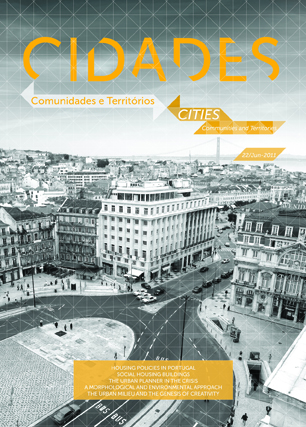Edifícios de Habitação Social: Diagnóstico e Cenários de Intervenção no Edificado
Palabras clave:
Habitação Social, Espaço Público, Reabilitação Urbana, UrbanismoResumen
Este artigo decorre de um estudo de avaliação e diagnóstico das necessidades de intervenção em dois bairros sociais (a “Zona J” e a “Pantera Cor-de-rosa”), situados em Marvila (Chelas), na cidade de Lisboa, realizado por uma equipa do ISCTE - Instituto Universitário de Lisboa, para o IHRU - Instituto de Habitação e Reabilitação Urbana. No essencial, o estudo propõe um instrumento de apoio à decisão das entidades responsáveis – o Gabinete Viver Marvila do Instituto da Habitação e da Reabilitação Urbana (IHRU) e a Câmara Municipal de Lisboa (CML) – sobre o futuro dos bairros em causa. Projectados e construídos nas décadas de 70 e 80 do século XX, reconhecem-se nestes bairros problemas de conflitualidade, gestão e governabilidade, assim como um avançado estado de degradação e deterioração do património edificado e do espaço público. Actualmente, o problema da habitação em Portugal já se não trata de uma questão quantitativa mas sim qualitativa. O défice habitacional, sentido na época em que foram projectados e construídos estes conjuntos urbanos, tem vindo a deixar de estar no centro do debate. Por outro lado, decorridos cerca de 30 a 40 anos desde a sua construção, estes apresentam já um considerável nível de deterioração, fruto de vandalizações constantes e, sobretudo, da ausência de manutenção do próprio edificado, evidenciando indícios de inadequabilidade à população que neles reside. Tratando-se de bairros de habitação social, a população residente é constituída maioritariamente por indivíduos com baixos recursos, famílias numerosas, idosos e desempregados, agravando-se o potencial de criminalidade e insegurança. Questionámos, na investigação realizada, se o facto de a tipologia urbana (neste caso – edifícios de grande porte, organizados em galeria) teria reflexos na forma como os seus habitantes vivem e usufruem o bairro. O facto de não existir uma hierarquia definida entre espaços públicos, semi-públicos e privados, assim como a indefinição da ligação entre estes, conduziu à existência de espaços anónimos ou impessoais, cuja utilização e apropriação é pouco clara dificultando a possibilidade de vigilância por parte da população residente ou visitante. Procurámos igualmente responder a um conjunto de questões que, tendo sido levantadas com o aprofundar do estudo, nos parecem pertinentes e actuais, dado o número de bairros com características semelhantes existentes em Portugal. Quais as soluções tipológicas e construtivas contemporâneas que respondem aos desejos dos moradores e, ao mesmo tempo, respondem às actuais normas e regulamentos da edificação? Quais as soluções tipológicas e construtivas contemporâneas que respondem às necessidades reais de quem lá habita e que, simultaneamente, ressalvam os pressupostos de qualidade inequívoca do projecto original? O que é que existe para conservar, reforçar ou eliminar? Qual o conjunto de exemplos e boas práticas que deveriam pautar o património construído de habitação social colectiva, ou a sua reabilitação? Foi a algumas destas questões que procurámos dar resposta através de propostas concretas de reorganização espacial, a partir do edificado e dos espaços urbanos existentes.
Descargas
Publicado
Número
Sección
Licencia
Cidades, Comunidades e Territórios by DINÂMIA'CET-IUL is licensed under a Creative Commons Atribuição-Uso Não-Comercial-Proibição de realização de Obras Derivadas 4.0 Unported License.Permissions beyond the scope of this license may be available at mailto:cidades.dinamiacet@iscte.pt.






